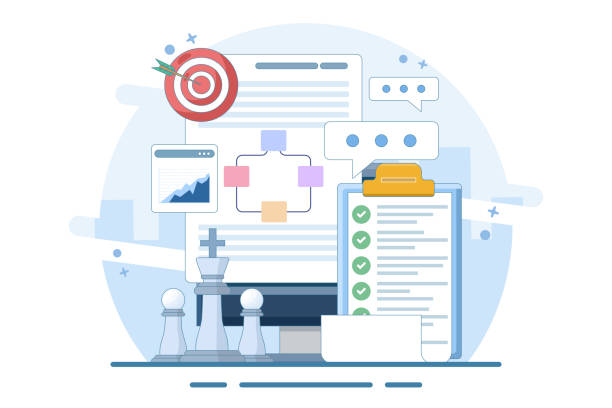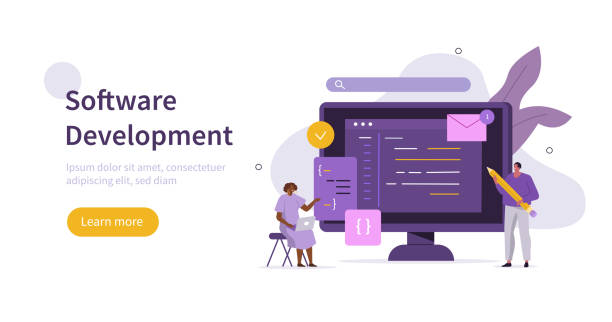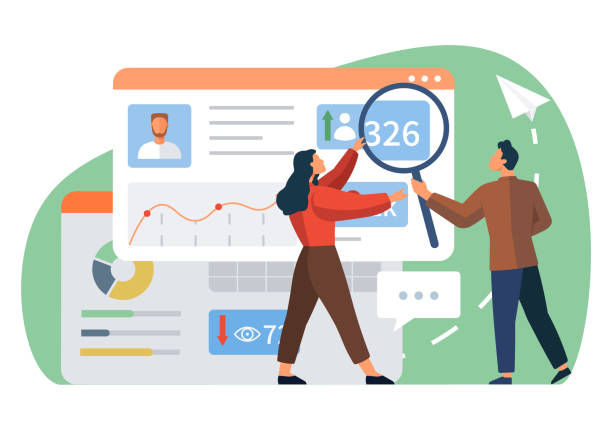Introduction to the Importance of Secure Website Design in the Digital World

In the current era, where online businesses are rapidly expanding and a massive volume of sensitive user and company information is exchanged in the digital space, the topic of #Secure_Website_Design has become more critical than ever.
An insecure website can lead to loss of customer data, serious damage to brand reputation, and even irreversible financial losses.
Therefore, understanding and implementing the principles of secure website design is not just a competitive advantage, but a vital necessity for any online business.
Website security not only helps protect sensitive information but also builds user trust and provides a better user experience.
This chapter explains the importance of this topic and lays the groundwork for better understanding subsequent discussions.
From cyberattacks to data breaches, news of website security violations is heard daily, underscoring the need for special attention to website security.
Investing in secure website design means investing in the future and sustainability of your business.
Without adhering to these principles, your website will always be exposed to serious risks and may be attacked at any moment.
This is just part of the reasons why every developer and business owner should prioritize web security and adopt a proactive approach, rather than seeking solutions after a disaster strikes.
Worried about losing customers because you don’t have a professional e-commerce site?
With Rassaweb’s e-commerce website design, forget these worries!
✅ Significant increase in sales and conversion rate of visitors to customers
✅ Professional and user-friendly design that builds customer trust
⚡ Get free consultation from Rassaweb
Common Vulnerabilities and Website Security Threats

To achieve #Secure_Website_Design, we must first become familiar with common vulnerabilities and threats that target websites.
This chapter analytically examines the most common cyberattacks that can jeopardize your website’s security.
Attacks such as SQL Injection, Cross-Site Scripting (XSS), Broken Access Control, and Distributed Denial of Service (DDoS) attacks are examples of these threats.
SQL Injection allows attackers to access the website’s database and steal or manipulate sensitive information by injecting malicious SQL code.
XSS also allows attackers to inject malicious code into the website to steal user information or take control of user sessions.
Broken Access Control occurs when users can access functions or data that they are not authorized to.
DDoS attacks make a website unavailable by sending a massive volume of traffic to the server.
Awareness of these vulnerabilities is the first step in the process of secure website design.
In addition to these, issues related to improper server configuration, weak password management, and the use of outdated and unpatched software can also open the door for attackers.
A deep understanding of these threats helps you adopt a more comprehensive approach to securing your website and incorporate necessary measures to prevent these attacks in the early stages of secure website design, establishing a cohesive defensive plan.
The Role of SSL/TLS and HTTPS in Enhancing Website Security

One of the most fundamental and vital steps in #Secure_Website_Design is the use of SSL/TLS protocols and enabling HTTPS.
This chapter instructively shows you how these technologies can encrypt information exchanged between the user and the server and prevent eavesdropping or tampering by unauthorized individuals.
SSL (Secure Sockets Layer) and its newer generation TLS (Transport Layer Security) are protocols that provide secure communication between the user’s browser and the website server.
When a website uses HTTPS (HTTP Secure), it means that information is encrypted using SSL/TLS, making the data unreadable even if intercepted.
This feature is absolutely essential for any website that collects sensitive information such as passwords, credit card details, or personal data.
The presence of an SSL certificate not only guarantees communication security but also helps improve your website’s SEO ranking, as search engines prefer HTTPS websites and give them higher credibility in rankings.
There are different types of SSL certificates, including Domain Validation (DV) which only validates the domain, Organization Validation (OV) which also verifies the organization’s identity, and Extended Validation (EV) which provides the highest level of authentication and displays a green bar in the browser.
Proper implementation of these protocols and up-to-date certificate maintenance are an integral part of secure website design and building trust among users.
This initial but crucial step provides the foundation for a secure platform for your online activities.
| Feature | Description |
|---|---|
| Data Encryption | Makes information exchanged between the user and the server unreadable and prevents eavesdropping. |
| Website Authentication | Ensures that the user is connected to a legitimate website and is not subjected to phishing attacks. |
| User Trust and Brand Credibility | Displaying the green lock in the browser and the HTTPS protocol builds user trust and adds to business credibility. |
| SEO Ranking Improvement | Search engines like Google give higher scores to HTTPS websites, leading to improved rankings. |
| Prevention of MitM Attacks | Prevents Man-in-the-Middle (MITM) attacks where an attacker positions themselves between the user and the server. |
Secure Coding Practices and the Role of Developers

The foundation of #Secure_Website_Design lies in developers’ coding practices.
This chapter expertly examines the principles and techniques that programmers must employ when developing a website to prevent security vulnerabilities.
One of the most important principles is Input Validation; any data received from the user must be carefully checked and filtered to prevent attacks such as SQL Injection and XSS.
Using Prepared Statements or secure ORMs for database interaction, as well as filtering and escaping all outputs before displaying them to the user, are essential measures.
Additionally, secure and up-to-date libraries and frameworks should be used, which have their own internal security mechanisms and regularly receive security patches.
Keeping all software, frameworks, and libraries used up-to-date is also crucial to address their known vulnerabilities.
Proper error handling and displaying generic error messages instead of technical details that could provide information to an attacker, is also an important principle in secure website design.
Developers must continuously update their knowledge in cybersecurity, participate in training courses, and implement best practices in their coding.
This includes understanding concepts such as the Principle of Least Privilege in coding, API security, and proper session management.
By adhering to these principles, developers can help create a secure website and incorporate defensive layers from the very beginning of the software architecture.
Did you know your company website is the first point of contact for 75% of potential customers?
Your website is the face of your brand. With **Rassaweb**’s corporate website design services, build an online presence that earns customer trust.
✅ Create a professional and lasting image for your brand
✅ Attract target customers and increase online credibility
⚡ Get free consultation from **Rassaweb** experts!
Database Security: Protecting Sensitive Information

The database is the beating heart of every website and contains critical user and business information.
Therefore, #Database_Security is an integral and highly important component of #Secure_Website_Design.
This chapter provides a comprehensive guide to protecting sensitive data in the database.
The first step is to apply the Principle of Least Privilege; meaning that users, applications, and services should only have access to the information and operations they need to perform their tasks.
Encrypting sensitive data, both at rest (like credit card information or medical records) and in transit (like when data is sent between the server and the database), is very important.
Using strong encryption algorithms for passwords (such as bcrypt or Argon2) instead of storing them in plain text or MD5 is essential, and salting should always be used.
Also, regular backups of the database should be made, and these backups should be stored in secure and separate locations (preferably off-network and encrypted) to be accessible if the main server is lost, reducing the risk of permanent data loss.
Applying security patches and continuous updates for the Database Management System (DBMS) is also crucial to prevent known vulnerabilities.
Database firewalls and Intrusion Detection Systems (IDS) can also provide an additional layer of security.
Continuous monitoring of database logs to identify suspicious activities and intrusion attempts is also of high importance.
These measures, in general, help strengthen website security and are one of the main pillars of secure website design.
Firewalls and Intrusion Detection Systems: Network Defense Layers

Alongside secure coding and proper server configuration, the use of firewalls and Intrusion Detection Systems (IDS) forms vital defense layers in #Secure_Website_Design.
This chapter explains the function of these tools in protecting your website and clarifies their key differences.
A Firewall acts as a security barrier between the internal network and the internet, filtering incoming and outgoing traffic based on predefined rules.
This tool can block unauthorized access and prevent malware entry and intrusion attempts.
There are different types of firewalls, including network firewalls, host firewalls, and especially Web Application Firewalls (WAF – Web Application Firewall), which are specifically designed to protect web applications against common Layer 7 attacks such as SQL Injection, XSS, and brute-force attacks.
On the other hand, Intrusion Detection Systems (IDS) and Intrusion Prevention Systems (IPS) monitor network traffic to identify suspicious patterns or malicious activities.
IDS only issues alerts, while IPS, in addition to detection, is also capable of blocking or preventing the attack from continuing.
These systems can operate based on signatures (identifying known attack patterns) or anomalies (identifying unusual activities).
The combined use of firewalls (especially WAF) and IDS/IPS creates a strong multi-layered defense that significantly enhances overall website security and ensures a comprehensive approach to secure website design.
These tools act as vigilant guardians who constantly monitor the health and security of your website environment.
Regular Security Audits and Penetration Testing: A Proactive Approach

To ensure the sustainability of #Secure_Website_Design, regular security audits and Penetration Testing are essential.
This chapter newsworthy addresses the importance of these proactive approaches and how they help identify and fix vulnerabilities before attackers can exploit them.
A security audit involves a comprehensive review of source code, server configuration, network settings, and organizational security policies.
Its purpose is to identify weaknesses and provide recommendations for strengthening security.
These audits can be performed by an internal team or external specialists and provide deep insight into the current security posture.
Penetration testing goes beyond auditing; in this process, security experts attempt to infiltrate the system using techniques similar to real hackers to identify operational vulnerabilities.
This process typically includes stages of Reconnaissance, Scanning, Exploitation, and Post-Exploitation.
Penetration testing can be performed as black-box (without prior knowledge of the system, simulating an external attacker’s approach), grey-box (with partial knowledge), or white-box (with full access to code and infrastructure).
Penetration test reports provide valuable information for the development team to address security issues and continuously improve website security.
These measures not only help maintain website security but also lead to compliance with security standards and increased customer trust.
Companies that regularly perform these tests take a big step towards secure website design and can protect themselves against growing threats.
| Feature | Security Audit | Penetration Test |
|---|---|---|
| Main Goal | Identify weaknesses and provide recommendations through document and code review. | Simulate real attacks to discover exploitable vulnerabilities in practice. |
| Methodology | Review code, configuration, architecture, and security policies. | Attempt to infiltrate the system using hacker tools and techniques. |
| System Knowledge Required | Often requires deep knowledge of the system (usually White Box). | Can be done without knowledge (Black Box) or with knowledge (White Box/Grey Box). |
| Output | A list of vulnerabilities, general recommendations, and compliance report. | Detailed report of attack vectors, operational vulnerabilities, and corrective actions. |
User Authentication and Authorization: Precise Access Control

Proper management of user Authentication and Authorization is a core pillar of #Secure_Website_Design.
This chapter instructively explains how to implement strong mechanisms to ensure that only authorized users have access to specific information and functionalities.
For authentication, using strong and unique passwords, regular password change policies, and Two-Factor Authentication (2FA) or Multi-Factor Authentication (MFA) is essential.
2FA provides an extra layer of security, making it difficult to access a user account even if the password is stolen, as the attacker does not have access to the second factor (such as a code sent to a mobile phone).
In terms of authorization, appropriate access control models such as Role-Based Access Control (RBAC) should be used.
This model allows you to define access based on users’ roles in the system, so that a normal user, an administrator, and a senior user each have access only to their relevant sections, and no more.
Session Management is also of high importance; it must be ensured that sessions are properly created, managed, and securely destroyed after a specified period of inactivity or after the user logs out.
Preventing Session Fixation and Session Hijacking through the use of secure tokens and encrypted protocols is also vital.
All these measures contribute to strengthening user login security and protecting data within the framework of secure website design and prevent unauthorized access.
Is your current e-commerce website design causing you to lose customers and sales?
Rassaweb is your solution with modern and user-friendly e-commerce website designs!
✅ Significant increase in conversion rates and sales
✅ Strong branding and building customer trust
⚡ Get free e-commerce website design consultation from Rassaweb!
Backup and Data Recovery in Case of Disaster: Are You Ready?
![]()
One of the often-overlooked aspects of #Secure_Website_Design is planning for Backup and Disaster Recovery.
This chapter, with its thought-provoking content, reminds you that even with the best security measures, unforeseen events such as hardware failure, sophisticated malware attacks, or human error can lead to data loss.
Is your website ready for such situations? Having a comprehensive backup strategy, including regular and automated backups of the database and website files, is essential.
These backups should be stored in secure and separate locations (preferably in cloud storage or external servers with encryption support) to be accessible if the main server is lost, reducing the risk of permanent information loss.
Also, a documented Disaster Recovery Plan (DRP) should be in place, outlining detailed steps to restore the website to an operational state after a disaster.
This plan should be regularly tested to ensure its effectiveness and have defined Recovery Time Objective (RTO) and Recovery Point Objective (RPO).
Ignoring this step could mean the complete annihilation of your business in the event of a serious attack or disaster.
A truly secure website doesn’t just think about protecting itself from attacks, but is also prepared for the worst-case scenarios and can quickly return to normal operation after a disaster.
So, the question is: Have you really considered how you will restore your website if it goes down tomorrow, and how long it will take? This preparedness is an inseparable and very important part of secure website design that ensures the health and sustainability of your business.
The Future of Web Security and Upcoming Challenges

The world of cybersecurity is constantly changing and evolving, and new threats and technologies emerge daily.
In this chapter, in an entertaining yet informative way, we explore future trends in #Secure_Website_Design and the challenges facing developers and security professionals.
With the advent of technologies such as Artificial Intelligence (AI) and Machine Learning (ML), both attackers and defenders have gained more powerful tools.
Artificial Intelligence can play a key role in detecting complex attacks, analyzing vast amounts of data to identify suspicious patterns, and predicting new threats, but at the same time, attackers can also use it to automate attacks, advanced phishing, and create intelligent malware.
The emergence of quantum computing could also create new challenges for current encryption algorithms and raise the need for the development of Post-Quantum Cryptography protocols.
On the other hand, the increasing number of connected devices (IoT) and the spread of Supply Chain attacks have doubled the complexities of web security.
To address these challenges, a dynamic and continuous approach to web security is needed.
Continuous education, collaboration among experts, and investment in new security technologies pave the way for achieving secure website design.
Also, the DevSecOps concept, which integrates security from the beginning of the development cycle, is increasingly gaining importance.
The future of web security is a challenging but exciting path that constantly requires vigilance, innovation, and readiness to face the unknowns.
Frequently Asked Questions
| Question | Answer |
|---|---|
| What is secure website design? | Secure website design is a process in which websites are built with security principles in mind to be resistant to cyberattacks and to protect user and business information. |
| Why is secure website design of high importance? | To prevent unauthorized data access, sensitive information leaks, malware attacks, loss of user trust, damage to business reputation, and legal consequences of data breaches. |
| What are the most common website vulnerabilities? | SQL Injection, Cross-Site Scripting (XSS), Cross-Site Request Forgery (CSRF), Broken Authentication and Session Management, and Sensitive Data Exposure. |
| How can SQL Injection attacks be prevented? | By using Prepared Statements with parameterized queries, Input Validation, and limiting database access. |
| What are the methods to counter XSS (Cross-Site Scripting) attacks? | Input Validation, Output Encoding before displaying in HTML, and using Content Security Policy (CSP). |
| What is the role of HTTPS in website security? | HTTPS encrypts communication between the user’s browser and the website server using an SSL/TLS certificate, preventing eavesdropping, tampering, or data forgery. |
| What are the best practices for managing user passwords? | Enforcing strong passwords (a combination of letters, numbers, and symbols), hashing passwords instead of storing them directly (with strong algorithms like bcrypt), and enabling Two-Factor Authentication (2FA). |
| What is the importance of User Input Validation? | Input validation prevents malicious or unexpected data from entering the system, which could lead to vulnerabilities like SQL Injection or XSS. |
| What is the effect of regular security reviews and audits on website security? | These reviews help identify vulnerabilities and security weaknesses early, allowing them to be fixed before they can be exploited. |
| What is the application of Web Application Firewall (WAF) in secure website design? | A WAF acts as a protective layer between the user and the website, analyzing incoming traffic, identifying, and blocking common web attacks such as SQL Injection and XSS. |
And other services of Rassaweb Advertising Agency in the field of advertising
Smart Advertising Campaign: A creative platform for improving campaign management using real data.
Smart SEO: A dedicated service for improving SEO ranking based on marketing automation.
Smart Marketing Automation: A creative platform for increasing sales with precise audience targeting.
Smart Marketing Automation: Revolutionize website traffic increase with the help of real data.
Smart SEO: An effective tool for digital branding with attractive UI design.
And over hundreds of other services in the field of internet advertising, advertising consultation, and organizational solutions
Internet Advertising | Advertising Strategy | Advertorials
Sources
Website Security: A Complete Guide for Online Businesses
Principles of Secure Website Design and Key Tips
Website Security Checklist for Online Stores
15 Tips to Increase WordPress Site Security
? With Rassaweb Afarin, transform your business in the digital world. We help you shine in today’s competitive market and achieve your goals by providing comprehensive digital marketing services, including custom website design.
📍 Tehran, Mirdamad Street, next to Bank Markazi, Southern Kazeroun Alley, Ramin Alley, No. 6



